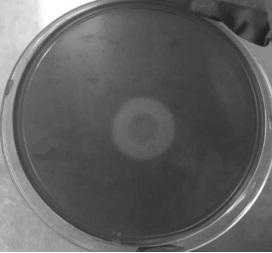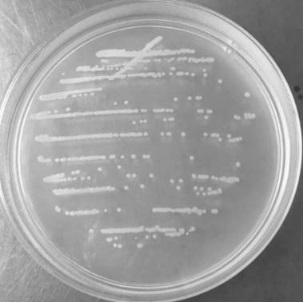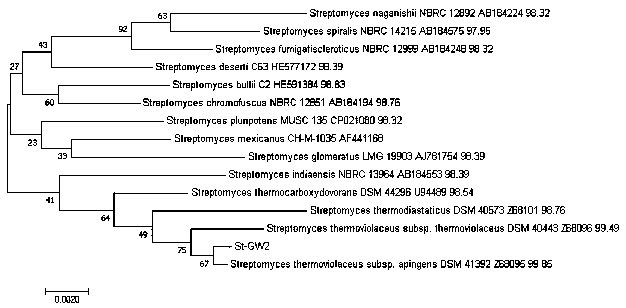High-temperature Streptomyces thermoviolaceus and application of High-temperature Streptomyces thermoviolaceus in cellulose degradation
A technology of Streptomyces violaceum and cellulose, applied in the field of agricultural resources and environmental microorganisms, can solve problems such as unreported, unsuitable for large-scale industrial application, and small biomass.
- Summary
- Abstract
- Description
- Claims
- Application Information
AI Technical Summary
Problems solved by technology
Method used
Image
Examples
Embodiment 1
[0032] Example 1 Streptomyces violaceum St-GW2 strain improved CMC solid culture and Congo red staining experiment
[0033] For the composted samples of traditional Chinese medicine dregs in different sampling periods (from the compost of traditional Chinese medicine dregs in Donghai County, Lianyungang City, Jiangsu Province), take 5g and add them to 50 ml of sterilized ultrapure water, mix them evenly, centrifuge at 55°C and 150 rpm for 30 min, and take 1ml of the suspension Sequentially serially diluted, 100 µl of the diluted suspension was spread on the improved CMC solid medium, cultured in a 55°C incubator for 3 days, and the colonies on the improved CMC solid medium were streaked and purified, and the purified single strain was in Congo red staining was carried out after overnight culture on the improved CMC solid medium. After washing with 1 mol / L NaCl, there were transparent circles on the plate, which were possible high-temperature cellulose-degrading bacteria.
[00...
Embodiment 2
[0037] Example 2 Determination of Cellulase Activity of Streptomyces hyperthermicus Streptomyces violaceum St-GW2 strain
[0038] In order to measure the change curve of the enzyme activity of the strain, Streptomyces hyperthermicus St-GW2 was inoculated into the enzyme-producing fermentation medium, cultured at 55°C and 150 r / min for 14 days, and the strains were incubated at 1, 3, 5, 7, 9, On the 11th and 13th day, samples were taken for cellulase activity determination.
[0039] Enzyme activity detection method is as follows: CMCase measurement: Take 0.5ml of crude enzyme solution in a volumetric flask, add 1.5ml of 0.5mol / L, pH5.0 citric acid buffer solution containing 0.5% CMC-Na, and place in a water bath at 50°C Accurately act for 30 minutes, then add 1.5ml 3,5-dinitrosalicylic acid (DNS) solution, and immediately cool with running water after 5 minutes in boiling water bath. Measure its OD value at 540nm, and calculate the glucose content through the glucose standard ...
Embodiment 3
[0044] Example 3 Degradation ability of Streptomyces violaceum Streptomyces St-GW2 strain on filter paper cellulose
[0045] 1. Test tube filter paper degradation
[0046] The single colony of Streptomyces violaceum Streptomyces St-GW2 screened in Example 1 was inoculated into the improved test tube filter paper strip medium, and the filter paper strip without colonies was used as the control (K), and cultured under the same conditions as the initial screening temperature, Observe the ulceration of the filter paper strips.
[0047] The schematic diagram of the colony enrichment of strain St-GW2 in the test tube filter paper medium, the initiation of disintegration and the disintegration of the filter paper into a paste are shown in Figure 5 as shown, Figure 5 Among them, A, B, and C are pictures of test tubes cultured for 48h, 4d, and 8d in turn. It can be seen that at 48h, a large number of colonies are enriched and start to disintegrate ( Figure 5 A); at the 4th day, t...
PUM
 Login to View More
Login to View More Abstract
Description
Claims
Application Information
 Login to View More
Login to View More - R&D
- Intellectual Property
- Life Sciences
- Materials
- Tech Scout
- Unparalleled Data Quality
- Higher Quality Content
- 60% Fewer Hallucinations
Browse by: Latest US Patents, China's latest patents, Technical Efficacy Thesaurus, Application Domain, Technology Topic, Popular Technical Reports.
© 2025 PatSnap. All rights reserved.Legal|Privacy policy|Modern Slavery Act Transparency Statement|Sitemap|About US| Contact US: help@patsnap.com



